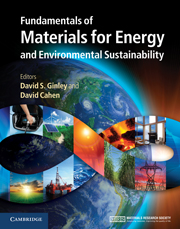Book contents
- Frontmatter
- Contents
- Contributors
- Preface
- Acknowledgments
- Part 1 Energy and the environment: the global landscape
- Part 2 Nonrenewable energy sources
- Part 3 Renewable energy sources
- Part 4 Transportation
- 31 Transportation: motor vehicles
- 32 Transportation: aviation
- 33 Transportation: shipping
- 34 Transportation: fully autonomous vehicles
- Part 5 Energy efficiency
- Part 6 Energy storage, high-penetration renewables, and grid stabilization
- Summary
- Appendix A Thermodynamics
- Appendix B Electrochemistry
- Appendix C Units
- Index
- References
34 - Transportation: fully autonomous vehicles
from Part 4 - Transportation
Published online by Cambridge University Press: 05 June 2012
- Frontmatter
- Contents
- Contributors
- Preface
- Acknowledgments
- Part 1 Energy and the environment: the global landscape
- Part 2 Nonrenewable energy sources
- Part 3 Renewable energy sources
- Part 4 Transportation
- 31 Transportation: motor vehicles
- 32 Transportation: aviation
- 33 Transportation: shipping
- 34 Transportation: fully autonomous vehicles
- Part 5 Energy efficiency
- Part 6 Energy storage, high-penetration renewables, and grid stabilization
- Summary
- Appendix A Thermodynamics
- Appendix B Electrochemistry
- Appendix C Units
- Index
- References
Summary
Focus
A new automotive “DNA” based on electrification and connectivity will be required in order to address the associated energy, environment, safety, and congestion challenges. What are the potential materials and design implications if future vehicles can sense and communicate with each other and the surroundings, drive autonomously, and do not crash?
Synopsis
Transformational change is coming to the automobile. Amid growing concerns about energy security, the environment, traffic safety, and congestion, there is an increasing realization that the 120-year-old foundational “DNA” of the automobile is not sustainable. In response, auto manufacturers are introducing a wide range of propulsion, electronics, and communications technologies. These will create a new automotive DNA, based on electrification and connectivity, and will profoundly affect personal mobility. Future vehicles are likely to be tailored to a range of specific uses, from short urban commutes to long-distance cargo hauling, and they will likely be energized by electricity and hydrogen. Unlike gasoline or diesel fuels, electricity and hydrogen can be made from primary energy sources that are diverse and can be made renewably. Future vehicles will be propelled with electric motors, perhaps in the wheels, and the braking, steering, and driving functions will be controlled electronically.
- Type
- Chapter
- Information
- Publisher: Cambridge University PressPrint publication year: 2011



